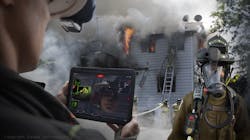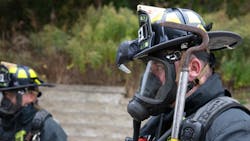Prototype Fire Helmet Mount Provides 'Iron Man' View
The road to technological innovation can start in some unusual locales. For Sam Cossman, the path to developing a new firefighting tool started while he was suspended above a volcano's crater in Nicaragua looking down on a lava lake the size of a football field.
As a researcher trying to find ways to operate in extreme environments, he discovered that he needed a better, safer way to work hands-free with gear that could survive such intense heat and rigorous conditions. So he decided to turn to a profession that had experience working with the type of gear he needed: the fire service.
What he found, however, was that the thermal imaging cameras (TICs) and other equipment firefighters relied on weren't well-suited for his research work—or for firefighting.
"It led to the realization that the fire service was using devices that left a lot to be desired," Cossman told Firehouse.com. "You needed your hands, and you needed to make sense of this gray-scale image that was counterintuitive. They're very expensive and clunky, and it became very clear why we couldn't use them in a volcano. ... There was a lot of room for improvements."
Instead of looking for answers in another profession to develop his research tool, Cossman pivoted. In 2015, he became one of the co-founders of the San Francisco startup Qwake Technologies, which began to develop a new tool for firefighters.
"It was this realization that men and women of the fire service who do incredible work were using tools that hadn't fundamentally changed for a long time," Cossman said. "It became very frustrating for us that what we believed was possible had only really been seen in the likes of sci-fi movies and comic books. It hadn't been applied to a community of people who arguably needed these tools more than anyone, certainly much more than the average consumer. I wanted to build a tool that was useful for a firefighter.
"I pulled together a team from a lot of different backgrounds, not just volcano exploration," he added. "Neuroscience experts who know how the brain processes vision under stress. Computer vision, on the software side, all the cool stuff that can be done with sensory data, visual data ... and product design and most importantly firefighting."
The device that was developed was the C-Thru Navigator helmet mount, and Qwake has been working with fire departments around the country, including Boston and Cosumnes, to hone it. Now, it's closing in on its final stages.
"The whole idea behind the platform was to build a tool that's one, first and foremost, useful to an individual firefighter," Cossman said. "The thought being if you can't build something that's useful to that individual—and we heard this time and time again from people who we've spoken with over the years—if it's not going to help me, I'm not going to take it (into a fire scene). It's an extra thing to worry about, a thing I've got to carry, a thing that could break."
This month, the Menlo Park Fire District, which has been helping to develop the device, is the first department in the country to purchase around 40 mounts, and it will continue to work with Qwake to create a final version.
A common description for the C-Thru Navigator is that it's Iron Man for firefighters, a comparison to the armored Marvel Comics superhero's futuristic heads-up display helmet that gives the character a wealth of mission information. In fact, Robert Downey Jr., the actor who portrayed Iron Man in the movies, has even provided a promotional video for the product.
"That alone is a game changer," said Menlo Park Fire Chief Harold Schapelhouman.
"Everyone wants to be the Iron Man. Not Superman, the Iron Man, Tony Stark," he added. "Wouldn't we all like to do what he can do in the movie. This is Tony Stark. You're Iron Man."
Ironman for Firefighters // C-THRU from Sam Cossman on Vimeo.
But Cossman is hesitant to fully embrace that comparison. While it's an effective soundbite, he doesn't think the Navigator's form should outweigh its potentially life-saving function.
"The Iron Man stuff is flashy, but it's not what helps," he said.
The C-Thru Navigator is based around the idea of a hands-free TIC that attaches to a firefighter's helmet. It incorporates augmented-reality optics through a flip-down eye piece that gives the wearer a view of a fire scene that isn't obscured by smoke and soot.
"It feels like a video game," said Capt. Walt Vidosh, Menlo's tools and equipment coordinator who has helped kick the Navigator's tires and backed the district trying out the device. "Is this really what I was seeing? … I was blown away."
Besides the hands-free aspect, one of the C-Thru Navigator's essential features is its ability to be clearly viewed even in the harshest of environments. Even though TICs are highly effective at fire scenes, Schapelhouman and Vidosh admit that conditions can obscure a firefighter's view of the screen.
"We kind of had these conflicting views: One, of not being able to see a gray image in smoke, and two, this need to engage your memory every two seconds just to make sense of what you're trying to see on the screen," Cossman said. "And thirdly, using your hand to hold that screen in front of your eye, which as many firefighters have shared with us is kind of your lifeline as you're crawling around trying to map a room with your hands, not going to be able to see a gray image in the smoke."
The C-Thru Navigator, however, solves that problem by using high-contrast outlines in a green hue that is best suited for and highly visible to the human eye.
"The helmet makes it feel like it's more normal," Schapelhouman said.
"It becomes easy on the eyes, and you're hands-free," Vidosh added. "The stress on your body is so much less."
Along with providing a clearer, real-time view of an environment, the Navigator also can help reorient firefighters in a fire scene by providing directional cues that allow wearers to retrace their steps back the way they came into a space. And if a firefighter does become lost in a burning building, a mayday function can be activated, which alerts other C-Thru wearers in the area where to go to find the distressed first responder.
RELATED:
Qwake Technologies will be selecting nine more fire departments to partner with in the next month to lead the nation’s first C-Thru Navigator deployments. Find out how to apply by going to the company's website.
"If you get disoriented, you can press the mayday button and the closest person to you can come find you," Vidosh said, adding that the location information pops up on the eyepiece in real-time.
The cellular- and WiFi-connected technology in the Navigator also can transmit data to a tablet application that can give incident commanders real-time video feeds and other tools to coordinate efforts. The information then is saved so that firefighters in the field or in an after-actions or training setting can evaluate situations and decision-making.
So far, Vidosh says that firefighters in his department who have tested the prototype have liked what they've seen. While he's fielded questions from his colleagues about the device, he hasn't come across complaints.
Menlo Park now will be deploying the C-Thru Navigator in the field to run it through its paces. Not only will firefighters be testing how the tech performs in real-world conditions, but also making sure it's durable enough to withstand conditions that aren't impressed by movie superhero displays and green outlines.
This next phase also could bring additional improvements to the device, and Vidosh said he could see other uses for the Navigator beyond a structure fire. Urban search-and-rescue teams, as well as law enforcement agencies, could benefit from it.
"I could see it being used at night when you're searching for a victim," Vidosh said. "I could see a lot of different uses for this."
Although Cossman ended up solving a different problem than when he started, he has found working to create an effective tool for the fire service to be one of the most rewarding experiences of his career.
"I didn't really know the fire service when I came to it. It's taken building a relationship with many of them over the past five to seven years to understand why this mission is so important," he said. "To be honest, it's been one of the greatest honors of my life to see it for what it is: a community of people who quite literally give everything of themselves for the betterment of their own communities."
"Firefighters are some of the best people I've ever met," Cossman added. "They give everything of themselves. They are some of the most earnest, truest, wonderful people that I've had the pleasure of knowing, and it feels good to work on something that I truly believe in my heart of hearts is going to fundamentally change the industry."
And for the Menlo Park Fire District, the relationship with Qwake has been mutually rewarding.
"My guys are excited about this. They feel like they're part of the process, because they are and they have been for years already," Schapelhouman said. "I think you put this in any firefighter's hand across the country, no one is going to say they don't want it."
But Vidosh summed up the biggest potential benefit to partnering up: improving firefighter and public safety.
"If we can use this device and save at least one person, then it will have been worth it," he said. "It's all about making us more efficient."


